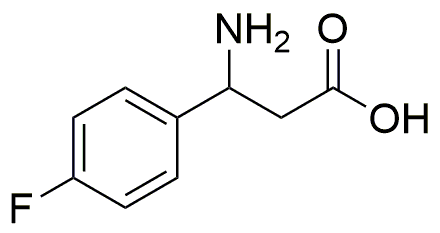3-Amino-3-(4-fluorophenyl)propionic acid is widely utilized in research focused on:
- Pharmaceutical Development: This compound serves as a building block in the synthesis of various pharmaceuticals, particularly in the development of drugs targeting neurological disorders.
- Neurotransmitter Research: It is used in studies related to neurotransmitter modulation, helping researchers understand its effects on brain chemistry and potential therapeutic applications.
- Biochemical Assays: The compound is employed in biochemical assays to evaluate enzyme activity and receptor interactions, providing insights into metabolic pathways.
- Material Science: It finds applications in creating novel materials with specific properties, such as polymers that exhibit enhanced thermal stability and mechanical strength.
- Analytical Chemistry: This chemical is utilized in analytical methods for detecting and quantifying amino acids in various samples, aiding in quality control in food and pharmaceutical industries.
General Information
Properties
Safety and Regulations
Applications
3-Amino-3-(4-fluorophenyl)propionic acid is widely utilized in research focused on:
- Pharmaceutical Development: This compound serves as a building block in the synthesis of various pharmaceuticals, particularly in the development of drugs targeting neurological disorders.
- Neurotransmitter Research: It is used in studies related to neurotransmitter modulation, helping researchers understand its effects on brain chemistry and potential therapeutic applications.
- Biochemical Assays: The compound is employed in biochemical assays to evaluate enzyme activity and receptor interactions, providing insights into metabolic pathways.
- Material Science: It finds applications in creating novel materials with specific properties, such as polymers that exhibit enhanced thermal stability and mechanical strength.
- Analytical Chemistry: This chemical is utilized in analytical methods for detecting and quantifying amino acids in various samples, aiding in quality control in food and pharmaceutical industries.
Documents
Safety Data Sheets (SDS)
The SDS provides comprehensive safety information on handling, storage, and disposal of the product.
Product Specification (PS)
The PS provides a comprehensive breakdown of the product’s properties, including chemical composition, physical state, purity, and storage requirements. It also details acceptable quality ranges and the product's intended applications.
Certificates of Analysis (COA)
Search for Certificates of Analysis (COA) by entering the products Lot Number. Lot and Batch Numbers can be found on a product’s label following the words ‘Lot’ or ‘Batch’.
*Catalog Number
*Lot Number
Certificates Of Origin (COO)
This COO confirms the country where the product was manufactured, and also details the materials and components used in it and whether it is derived from natural, synthetic, or other specific sources. This certificate may be required for customs, trade, and regulatory compliance.
*Catalog Number
*Lot Number
Safety Data Sheets (SDS)
The SDS provides comprehensive safety information on handling, storage, and disposal of the product.
DownloadProduct Specification (PS)
The PS provides a comprehensive breakdown of the product’s properties, including chemical composition, physical state, purity, and storage requirements. It also details acceptable quality ranges and the product's intended applications.
DownloadCertificates of Analysis (COA)
Search for Certificates of Analysis (COA) by entering the products Lot Number. Lot and Batch Numbers can be found on a product’s label following the words ‘Lot’ or ‘Batch’.
*Catalog Number
*Lot Number
Certificates Of Origin (COO)
This COO confirms the country where the product was manufactured, and also details the materials and components used in it and whether it is derived from natural, synthetic, or other specific sources. This certificate may be required for customs, trade, and regulatory compliance.


